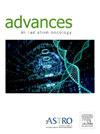在接受现代放射治疗的乳腺癌幸存者中,心肺亚结构剂量与心肺健康无关。
IF 2.2
Q3 ONCOLOGY
引用次数: 0
摘要
目的:乳腺癌放射治疗(RT)技术历来提供5 Gy范围内的平均心脏剂量(mhd),这已被发现使患者易患心肺毒性。本研究的目的是应用人工智能(AI)心脏亚结构自动分割来评估相应的亚结构剂量,这些剂量是否存在偏侧性和技术特异性差异,以及剂量是否与最先进的乳腺癌RT计划和交付后的心肺健康显著相关。方法与材料:采用人工智能对心肺亚结构进行自动分割。从2007年到2021年,65名乳腺癌幸存者在接受放疗后的中位数为2.3年(范围1.1-9.8年)时进行心肺功能评估。使用线性回归评估9个AI自动分段心肺亚结构、对侧肺和同侧肺的平均剂量与心肺适应性之间的关系。结果:中位MHD为0.64 Gy(范围0.12-7.1)。在自动分割的亚结构中,左心室的平均剂量最高(中位数,0.88 Gy)。接受体积调节电弧治疗的女性11个结构的平均剂量明显更高(MHD中位数,3.8 Gy vs 0.57 Gy;P < 0.0001)。患有左侧乳腺癌的女性MHDs明显更高(0.97 vs 0.38 Gy;P < 0.0001),这是由于4个心室中有3个心室的剂量较高,也由于肺动脉剂量显著较高(中位数,0.93 vs 0.32 Gy;P = .0003);右侧乳腺癌患者的腔静脉和右心房剂量明显更高(例如,右心房中位数,0.74 Gy vs 0.29 Gy;P = 0.0002)。在调整年龄、化疗药物、体积调节弧线治疗、放疗位置和放疗范围后,无心肺结构剂量与降低的心肺适能显著相关。结论:最先进的乳腺癌放射治疗降低了心肺剂量,并且在整个心肺系统中存在技术和癌症侧位放射治疗剂量依赖性。本文章由计算机程序翻译,如有差异,请以英文原文为准。
Cardiopulmonary Substructure Doses are Not Correlated With Cardiorespiratory Fitness Among Breast Cancer Survivors Treated With Contemporary Radiation Therapy
Purpose
Breast cancer radiation therapy (RT) techniques have historically delivered mean heart doses (MHDs) in the range of 5 Gy, which have been found to predispose patients to cardiopulmonary toxicities. The purpose of this study was to apply artificial intelligence (AI) cardiac substructure auto-segmentation to evaluate the corresponding substructure doses, whether there are laterality- and technique-specific differences in these doses, and if the doses are significantly associated with cardiorespiratory fitness after state-of-the-art RT planning and delivery for breast cancer.
Methods and Materials
Cardiopulmonary substructures were AI auto-segmented. Cardiorespiratory fitness was evaluated at a median of 2.3 (range, 1.1-9.8) years following RT from 2007 to 2021 among 65 breast cancer survivors. The associations between the mean dose to each of the 9 AI auto-segmented cardiopulmonary substructures, the contralateral, and the ipsilateral lung with cardiorespiratory fitness were evaluated using linear regression.
Results
The median MHD was 0.64 Gy (range, 0.12-7.1). Among the auto-segmented substructures, the highest mean doses were observed for the left ventricle (median, 0.88 Gy). The mean dose to each of the 11 structures was significantly higher for women treated with volumetric modulated arc therapy (MHD median, 3.8 Gy vs 0.57 Gy; P < .0001). Women with left-sided breast cancer had significantly higher MHDs (0.97 vs 0.38 Gy; P < .0001) due to higher doses in 3 of 4 cardiac chambers and also due to significantly higher pulmonary artery doses (median, 0.93 vs 0.32 Gy; P = .0003); women with right-sided breast cancer had significantly higher vena cava and right atrium doses (eg, right atrium median, 0.74 vs 0.29 Gy; P = .0002). No cardiopulmonary structure dose was significantly associated with reduced cardiorespiratory fitness after adjusting for age, chemotherapy agent, volumetric modulated arc therapy, RT position, and RT extent.
Conclusions
State-of-the-art breast cancer RT reduces cardiopulmonary dose, and there is a technique and cancer laterality RT dose dependence throughout the cardiopulmonary system.
求助全文
通过发布文献求助,成功后即可免费获取论文全文。
去求助
来源期刊

Advances in Radiation Oncology
Medicine-Radiology, Nuclear Medicine and Imaging
CiteScore
4.60
自引率
4.30%
发文量
208
审稿时长
98 days
期刊介绍:
The purpose of Advances is to provide information for clinicians who use radiation therapy by publishing: Clinical trial reports and reanalyses. Basic science original reports. Manuscripts examining health services research, comparative and cost effectiveness research, and systematic reviews. Case reports documenting unusual problems and solutions. High quality multi and single institutional series, as well as other novel retrospective hypothesis generating series. Timely critical reviews on important topics in radiation oncology, such as side effects. Articles reporting the natural history of disease and patterns of failure, particularly as they relate to treatment volume delineation. Articles on safety and quality in radiation therapy. Essays on clinical experience. Articles on practice transformation in radiation oncology, in particular: Aspects of health policy that may impact the future practice of radiation oncology. How information technology, such as data analytics and systems innovations, will change radiation oncology practice. Articles on imaging as they relate to radiation therapy treatment.
 求助内容:
求助内容: 应助结果提醒方式:
应助结果提醒方式:


